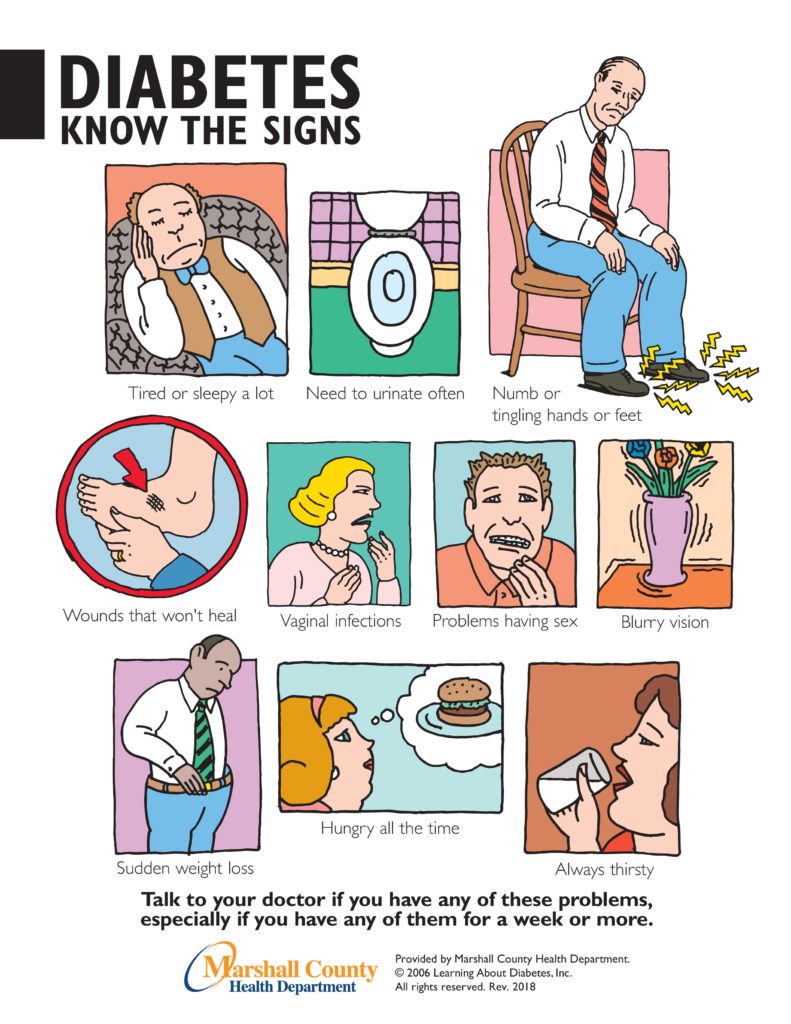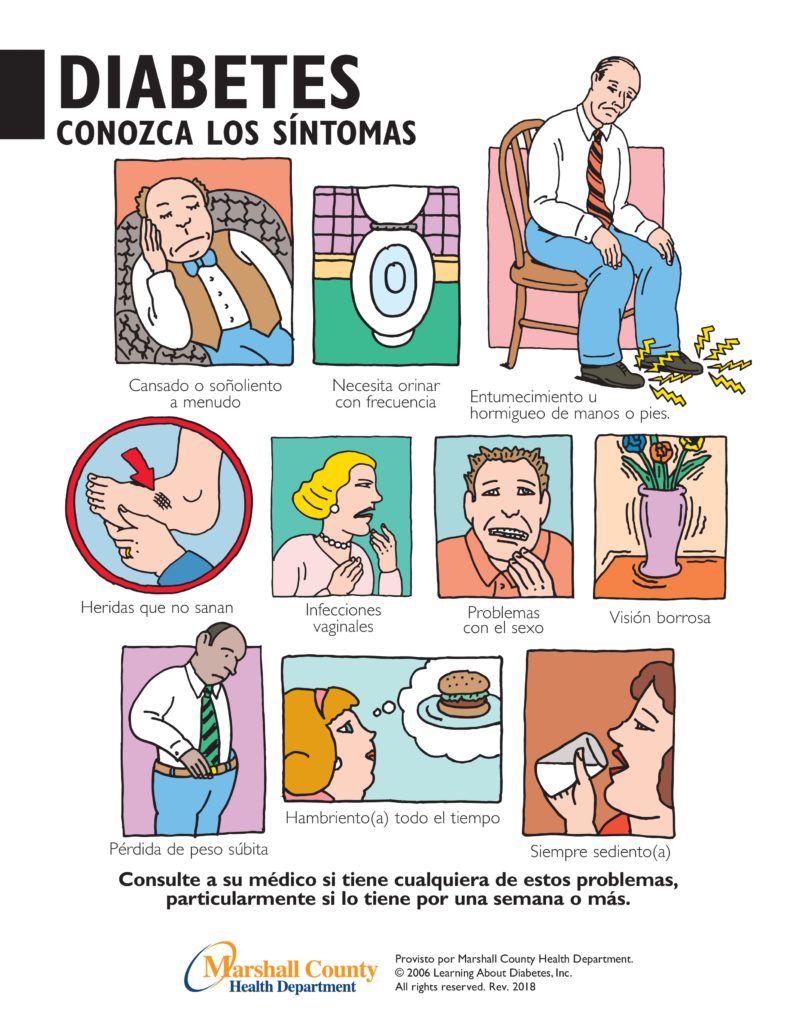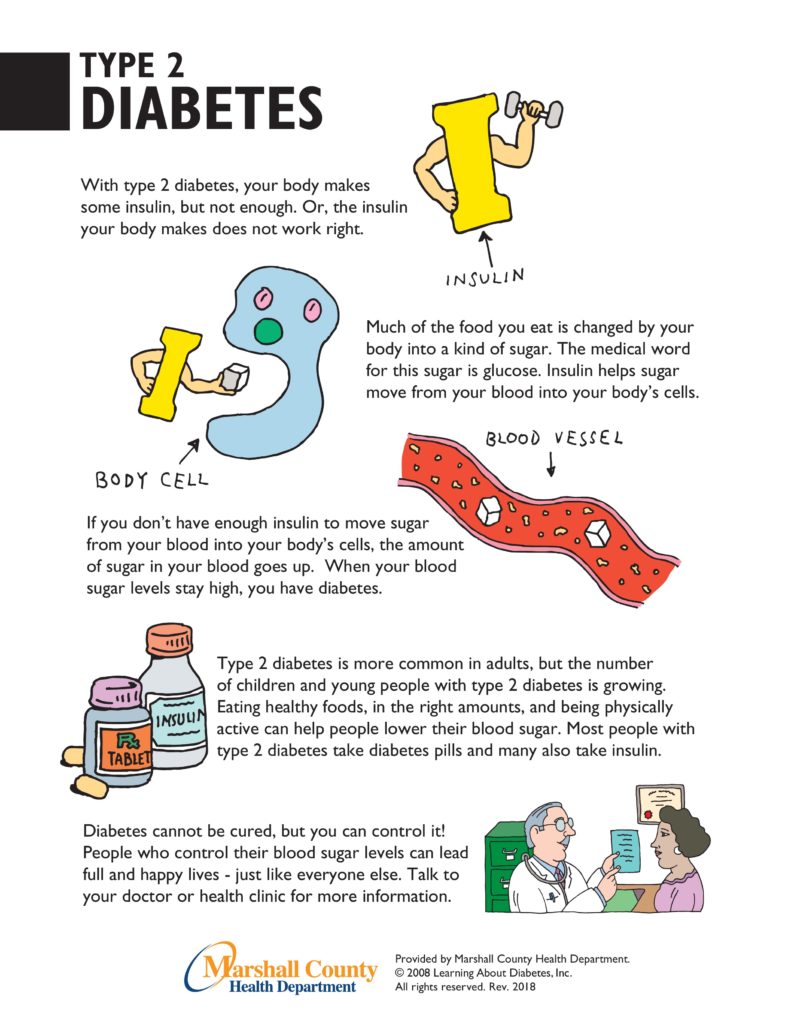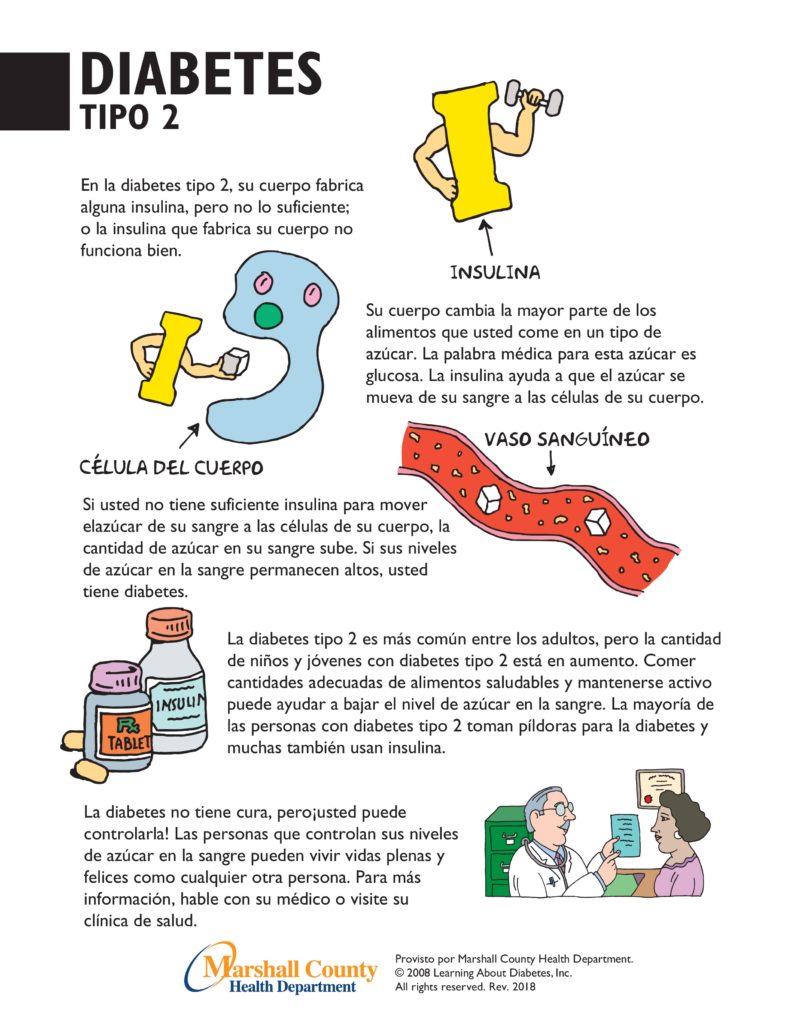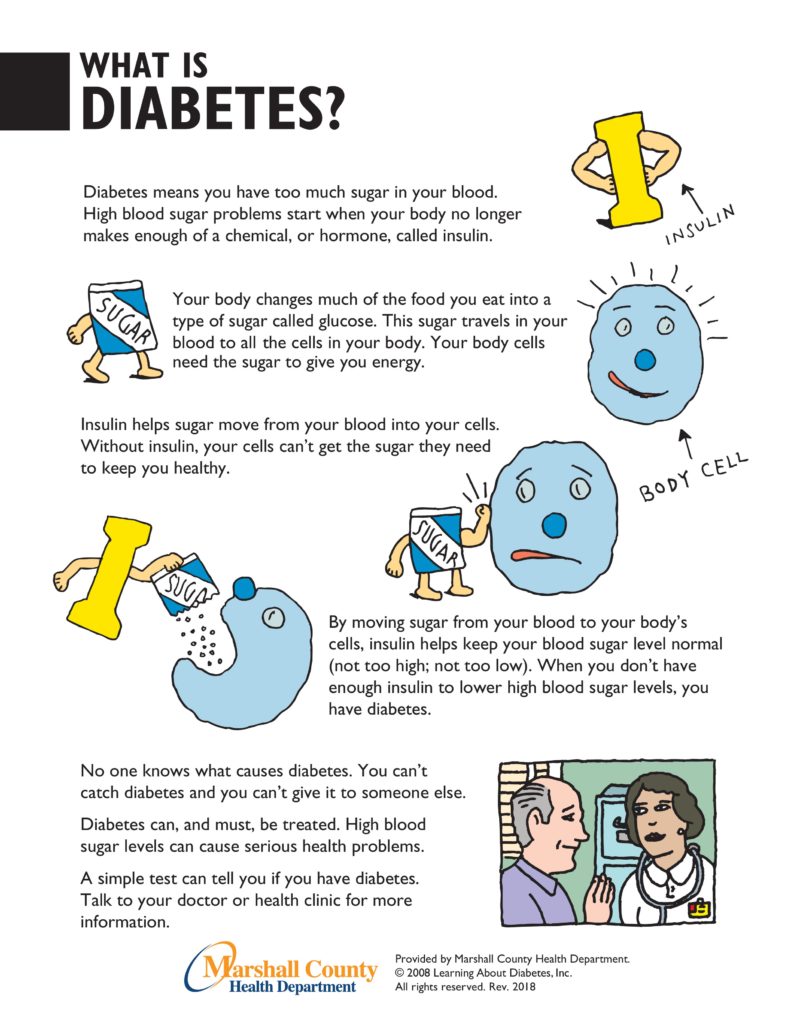Diabetes Education
Diabetes is a disorder that affects the way the body uses digested food for growth and energy. Normally, most food is broken down into glucose (sugar). The glucose is absorbed into the blood stream, where it is used by cells for growth and energy. Insulin, a hormone produced in the pancreas, must be present for glucose to enter the cells. People with diabetes either do not produce enough insulin or the insulin they produce is not used effectively by fat, muscle and liver cells. The results are a build-up of glucose (sugar) in the blood, which overflows into the urine, passes out of the body, without fulfilling its role as the body’s fuel source.
There are 3 main types of diabetes, type 1, type 2, and gestational diabetes:
- Type 1 diabetes was previously called insulin-dependent diabetes mellitus (IDDM) or juvenile-onset diabetes and may account for 5%-10% of all diagnosed cases of diabetes. Risks for developing type 1 diabetes may involve autoimmune, genetic, and/or environmental factors.
- Type 2 diabetes was previously called non-insulin dependent diabetes mellitus (NIDDM) or adult-onset diabetes and may account for about 90%-95% of all diagnosed cases of diabetes. Risks for developing type 2 diabetes include: older age, obesity, family history of diabetes, prior history of GDM, impaired glucose tolerance, physical inactivity, and race/ethnicity.
- Gestational diabetes (GDM) develops in 2%-5% of all pregnancies, but usually goes away when the pregnancy is over. GDM occurs more often in certain racial/ethnic groups and obese women are at a higher risk for GDM. Women who have had GDM are at increased risk for developing type 2 diabetes later in life.
- Pre-diabetes, also called impaired glucose tolerance or impaired fasting glucose, occurs when your blood sugar levels are higher than normal but not high enough for a diagnosis of diabetes. Having pre-diabetes puts you at higher risk for developing type 2 diabetes. You are also at increased risk for developing heart disease.
Preventing or delaying the onset of type 2 diabetes is possible, recent studies have shown that regular physical activity and modest weight loss can significantly reduce the risk of developing type 2 diabetes. You are more likely to develop type 2 diabetes if:
- You are overweight
- You are 45 years or older
- You have a parent, brother, or sister with diabetes
- Your family background is African American, American Indian, Asian American, Hispanic American/Latino, or Pacific Islander.
- You had gestational diabetes or gave birth to a baby weighing more than 9 pounds
- Your blood pressure is 140/90 or higher, or you have been told you have high blood pressure
- Your HDL cholesterol is 35 or lower, or your triglyceride level is 250 or higher
- You are fairly inactive, or you exercise fewer than three times a week
About 16 million people between the ages of 40 and 74 in United States have pre-diabetes. Most of them are likely to develop type 2 diabetes within 10 years, unless they take steps to prevent or delay diabetes. The results of the Diabetes Prevention Program tell us that millions of high risk people can use diet, exercise, and behavior modification to avoid developing type 2 diabetes
Symptoms of Diabetes
If you think you might have diabetes visit your physician for diagnosis. You might have SOME or NONE of the following symptoms:
- Frequent urination
- Excessive thirst
- Unexplained weight loss
- Extreme hunger
- Sudden vision changes
- Tingling and numbness in hands or feet
- Feeling very tired much of the time
- Very dry skin
- Sores that are slow to heal
- More infections than usual
Diabetes is a common, serious, costly, and controllable disease that affects thousands of individuals in Kentucky and poses a major public health problem. Much of the sickness and death associated with diabetes can be eliminated through treatment approaches including normalization of blood glucose levels, routine physician visits, self-management training, a yearly dilated eye exam, routine foot exams, and A1C checks.
The following information provides statistical data relating to diabetes in Kentucky as well as our nation:
- American Diabetes Association Website
- CDC Diabetes Interactive Atlas
- CDC Diabetes Fact Sheet
- Living with Diabetes
- Stigma, Blame and Shame of Diabetes
Services offered at the Marshall County Public Health Department:
Our staff of Registered Dietitians provides a variety of both clinical and community nutrition services including:
- ONE-ON-ONE Nutrition Counseling Sessions – Medical Nutrition Therapy (MNT). Call our office to schedule an individual appointment during office hours Monday-Friday. Our RD’s are Medicare/Medicaid providers. Coverage of MNT visits under private insurers varies. If applicable, out-of-pocket cost for MNT in our department is set at a fixed, affordable rate.
- We can provide diabetes education at community events to promote health & wellness. If your school, university, business or other group is interested in our staff providing educational sessions/seminars, assistance with your Worksite Wellness program, and/or guest speaking at your facility, please contact our office and we’ll be happy to help.
Diabetes Quick Facts
- The number of Kentucky adults diagnosed with diabetes has more than doubled from 6.5% to the current rate of 13.1% from 2000 to 2016.
- An estimated 11% of adults in Marshall County were diagnosed with diabetes between 2015-2017.
- Prediabetes is a risk factor for type 2 diabetes. Being overweight, being age 45 or older, and being physically inactive are risk factors for prediabetes and type 2 diabetes.
- Diabetes is associated with several life-threatening complications including heart disease, stroke, blindness, kidney failure, lower-limb amputation, and ketoacidosis.
Tips for Diabetes Prevention
- Being physically active for at least 150 minutes per week can help maintain a healthy weight and control blood sugar levels. Physical activity includes walking, gardening, bicycling, or any other activity that increases your heart rate.
- Eating a healthy diet and losing weight if you are overweight decreases your risk of diabetes. A healthy diet for most individuals consists of a variety of fruits and vegetables, whole grains, low-fat dairy products, lean meats, beans, and nuts. Red and processed meats, sugary beverages and foods high in saturated fat (such as fried foods) should be limited.
- Quitting smoking.
Tips for Diabetes Management
- Increasing physical activity increases insulin sensitivity, lowering blood sugar levels and A1c.
- Eating a healthy, balanced diet with consistent carbohydrates (carbs) throughout the day will help control blood sugars, especially if you’re insulin-dependent. It is a common misconception that carbs are “bad” and should be avoided if you have diabetes. Carbs are a necessary fuel for our bodies and should be consumed in moderation at scheduled times throughout the day. Carbohydrate foods include breads, pastas, beans, milk, cheese, starchy vegetables such as potatoes, corn and peas.
- Regularly monitor your blood sugar levels as recommended by your primary care physician. If you are taking oral medications and/or insulin to control your diabetes, take them as prescribed and make regular follow-up visits with your doctor to make sure the dosages do not need to be adjusted.
There are 3 main types of diabetes, type 1, type 2, and gestational diabetes:
- Type 1 diabetes was previously called insulin-dependent diabetes mellitus (IDDM) or juvenile-onset diabetes and may account for 5%-10% of all diagnosed cases of diabetes. Risks for developing type 1 diabetes may involve autoimmune, genetic, and/or environmental factors.
- Type 2 diabetes was previously called non-insulin dependent diabetes mellitus (NIDDM) or adult-onset diabetes and may account for about 90%-95% of all diagnosed cases of diabetes. Risks for developing type 2 diabetes include: older age, obesity, family history of diabetes, prior history of GDM, impaired glucose tolerance, physical inactivity, and race/ethnicity.
- Gestational diabetes (GDM) develops in 2%-5% of all pregnancies, but usually goes away when the pregnancy is over. GDM occurs more often in certain racial/ethnic groups and obese women are at a higher risk for GDM. Women who have had GDM are at increased risk for developing type 2 diabetes later in life.
- Pre-diabetes, also called impaired glucose tolerance or impaired fasting glucose, occurs when your blood sugar levels are higher than normal but not high enough for a diagnosis of diabetes. Having pre-diabetes puts you at higher risk for developing type 2 diabetes. You are also at increased risk for developing heart disease.
Preventing or delaying the onset of type 2 diabetes is possible, recent studies have shown that regular physical activity and modest weight loss can significantly reduce the risk of developing type 2 diabetes. You are more likely to develop type 2 diabetes if:
- You are overweight
- You are 45 years or older
- You have a parent, brother, or sister with diabetes
- Your family background is African American, American Indian, Asian American, Hispanic American/Latino, or Pacific Islander.
- You had gestational diabetes or gave birth to a baby weighing more than 9 pounds
- Your blood pressure is 140/90 or higher, or you have been told you have high blood pressure
- Your HDL cholesterol is 35 or lower, or your triglyceride level is 250 or higher
- You are fairly inactive, or you exercise fewer than three times a week
About 16 million people between the ages of 40 and 74 in United States have pre-diabetes. Most of them are likely to develop type 2 diabetes within 10 years, unless they take steps to prevent or delay diabetes. The results of the Diabetes Prevention Program tell us that millions of high risk people can use diet, exercise, and behavior modification to avoid developing type 2 diabetes
Know the Signs of Diabetes
Type 2 Diabetes
What is Diabetes

